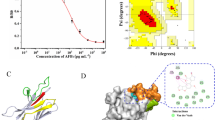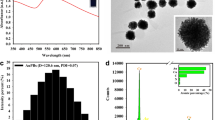Abstract
An integrated aflatoxin B1 (AFB1) detection platform with quantum dot (QD)-based electrochemical immunosensor and an automated magneto-controlled pretreatment system was successfully developed. The automated pretreatment system adopts the immunoaffinity magnetic beads (IMB) as the capture probe of AFB1 and QD-labeled AFB1 complete antigen (AFB1-BSA-QDs) as the signal probe. AFB1-BSA-QDs can be easily converted into corresponding metallic cations through acidic treatment, which can be detected electrochemically via anode stripping voltammetry (ASV). Moreover, a disposable screen-printed electrode (SPE) without requiring any further modification is used in the novel electrochemical immunosensor‚ making routine testing feasible. Under optimal conditions, the detectable concentration range of AFB1 was 0.08–800 μg/kg. The metal ion signal associated linearly with the logarithm of AFB1 concentration within the range of 5–240 μg/kg, with a detection limit of 0.05 μg/kg. The spiked recoveries of three different concentrations in four different matrixes ranged from 83.9 to 118.0%, and inter-day relative standard deviations were below 10%. Furthermore, the methodology was validated by analyzing naturally contaminated samples, and results of the novel immunosensor were in good agreement with those of LC-MS/MS, demonstrating the potentiality of the developed method for the monitor of AFB1 in cereals and oils.







Similar content being viewed by others
References
Keller NP, Turner G, Bennett JW. Fungal secondary metabolism-from biochemistry to genomics. Nat Rev Microbiol. 2005;3(12):937–47.
Hu Y, Zhang J, Kong W, Zhao G, Yang M. Mechanisms of antifungal and anti-aflatoxigenic properties of essential oil derived from turmeric (Curcuma longa L.) on Aspergillus flavus. Food Chem. 2017;220:1–8.
IARC. A review of human carcinogens: chemical agents and related occupations. IARC monographs on the evaluation of carcinogenic risks to humans, 2012; 100F.
Khlangwiset P, Shephard GS, Wu F. Aflatoxins and growth impairment: a review. Crit Rev Toxicol. 2011;41(9):740–55.
Van Egmond HP, JM. In Worldwide regulations for mycotoxins in food and feed in 2003. Rome: Food and Agriculture Organization of the United Nations, 2004.
Worldwide regulations for mycotoxins in food and feed in 2003. National Grain and Feed Association, FDA Mycotoxin Regulatory Guidance, a guide for grain elevators, feed manufacturers, grain processors and exporters, 2011.
European Commission. B Commission regulation (EC) No. 1881/2006 of 19 December 2006 setting maximum levels for certain contaminants in foodstuffs. Off J Eur Union. 2006:L364.
Chinese Ministry of Agriculture. GB 2761-2011. National Standards of the People’s Republic of China. 2017.
Huang X, Aguilar ZP, Xu H, Lai W, Xiong Y. Membrane-based lateral flow immunochromatographic strip with nanoparticles as reporters for detection: a review. Biosens Bioelectron. 2016;75:166–80.
Lee NA, Wang S, Allan RD, Kennedy IR. A Rapid Aflatoxin B1 ELISA: development and validation with reduced matrix effects for peanuts, corn, pistachio, and soybeans. J Agric Food Chem. 2004;52(10):2746–55.
Wang L, Wang Z, Gao W, Chen J, Yang M, Kuang Y, et al. Simultaneous determination of aflatoxin B1 and ochratoxin A in licorice roots and fritillary bulbs by solid-phase extraction coupled with high-performance liquid chromatography-tandem mass spectrometry. Food Chem. 2013;138(2–3):1048–54.
Wei R, Qiu F, Kong W, Wei J, Yang M, Luo Z, et al. Co-occurrence of aflatoxin B1, B2, G1, G2 and ochrotoxin A in Glycyrrhiza uralensis analyzed by HPLC-MS/MS. Food Control. 2013;32(1):216–21.
Liu S, Qiu F, Kong W, Wei J, Xiao X, Yang M. Development and validation of an accurate and rapid LC-ESI-MS/MS method for the simultaneous quantification of aflatoxin B1, B2, G1 and G2 in lotus seeds. Food Control. 2013;29(1):156–61.
Spanjer MC, Rensen PM, Scholten JM. LC-MS/MS multi-method for mycotoxins after single extraction, with validation data for peanut, pistachio, wheat, maize, cornflakes, raisins and figs. Food Addit Contam Part A Chem Anal Control Expo Risk Assess. 2008;25(4):472–89.
Evtugyn G, Porfireva A, Stepanova V, Sitdikov R, Stoikov I, Nikolelis D, et al. Electrochemical aptasensor based on polycarboxylic macrocycle modified with neutral red for aflatoxin B1 detection. Electroanalysis. 2014;26(10):2100–9.
Shim W-B, Mun H, Joung H-A, Ofori JA, Chung D-H, Kim M-G. Chemiluminescence competitive aptamer assay for the detection of aflatoxin B1 in corn samples. Food Control. 2014;36(1):30–5.
Sun L, Wu L, Zhao Q. Aptamer based surface plasmon resonance sensor for aflatoxin B1. Microchim Acta. 2017;184(8):2605–10.
Park JH, Kim Y-P, Kim I-H, Ko S. Rapid detection of aflatoxin B1 by a bifunctional protein crosslinker-based surface plasmon resonance biosensor. Food Control. 2014;36(1):183–90.
Wu S, Duan N, Zhu C, Ma X, Wang M, Wang Z. Magnetic nanobead-based immunoassay for the simultaneous detection of aflatoxin B1 and ochratoxin A using upconversion nanoparticles as multicolor labels. Biosens Bioelectron. 2011;30(1):35–42.
Chen Q, Yang M, Yang X, Li H, Guo Z, Rahma MH. A large Raman scattering cross-section molecular embedded SERS aptasensor for ultrasensitive Aflatoxin B1 detection using CS-Fe3O4 for signal enrichment. Spectrochim Acta A: Molec Biomolec Spectros. 2018;189:147–53.
Ko J, Lee C, Choo J. Highly sensitive SERS-based immunoassay of aflatoxin B1 using silica-encapsulated hollow gold nanoparticles. J Hazard Mater. 2015;285:11–7.
Bhardwaj H, Pandey MK, Rajesh SG. Electrochemical aflatoxin B1 immunosensor based on the use of graphene quantum dots and gold nanoparticles. Mikrochim Acta. 2019;186(8):592.
Sharma A, Kumar A, Khan R. Electrochemical immunosensor based on poly (3,4-ethylenedioxythiophene) modified with gold nanoparticle to detect aflatoxin B1. Mater Sci Eng C Mater Biol Appl. 2017;76:802–9.
Wang C, Qian J, An K, Ren C, Lu X, Hao N, et al. Fabrication of magnetically assembled aptasensing device for label-free determination of aflatoxin B1 based on EIS. Biosens Bioelectron. 2018;108:69–75.
Ma H, Sun J, Zhang Y, Xia S. Disposable amperometric immunosensor for simple and sensitive determination of aflatoxin B1 in wheat. Biochem Eng J. 2016;115:38–46.
Yugender Goud K, Sunil Kumar V, Hayat A, Vengatajalabathy Gobi K, Song H, Kim K-H, et al. A highly sensitive electrochemical immunosensor for zearalenone using screen-printed disposable electrodes. J Electroanal Chem. 2019;832:336–42.
Alonso-Lomillo MA, Dominguez-Renedo O, Roman Ldel T, Arcos-Martinez MJ. Horseradish peroxidase-screen printed biosensors for determination of Ochratoxin A. Anal Chim Acta. 2011;688(1):49–53.
Wang D, Gan N, Zhou J, Xiong P, Cao Y, Li T, et al. Signal amplification for multianalyte electrochemical immunoassay with bidirectional stripping voltammetry using metal-enriched polymer nanolabels. Sens Act B: Chem. 2014;197:244–53.
Wang J, Liu G, Merkoçi A. Electrochemical coding technology for simultaneous detection of multiple DNA targets. J Am Chem Soc. 2003;125(11):3214–5.
Hansen JA, Wang J, Kawde A-N, Xiang Y, Gothelf KV, Collins G. Quantum-dot/aptamer-based ultrasensitive multi-analyte electrochemical biosensor. J Am Chem Soc. 2006;128(7):2228–9.
Valera E, Garcia-Febrero R, Elliott CT, Sanchez-Baeza F, Marco MP. Electrochemical nanoprobe-based immunosensor for deoxynivalenol mycotoxin residues analysis in wheat samples. Anal Bioanal Chem. 2019;411(9):1915–26.
Wang C, Qian J, An K, Huang X, Zhao L, Liu Q, et al. Magneto-controlled aptasensor for simultaneous electrochemical detection of dual mycotoxins in maize using metal sulfide quantum dots coated silica as labels. Biosens Bioelectron. 2017;89(2):802–9.
Xuan Z, Ye J, Zhang B, Li L, Wu Y, Wang S. An automated and high-throughput immunoaffinity magnetic bead-based sample clean-up platform for the determination of aflatoxins in grains and oils using UPLC-FLD. Toxins. 2019;11(10):583.
Ye J, Xuan Z, Zhang B, Wu Y, Li L, Wang S, et al. Automated analysis of ochratoxin A in cereals and oil by immunoaffinity magnetic beads coupled to UPLC-FLD. Food Control. 2019;104:57–62.
Centi S, Silva E, Laschi S, Palchetti I, Mascini M. Polychlorinated biphenyls (PCBs) detection in milk samples by an electrochemical magneto-immunosensor (EMI) coupled to solid-phase extraction (SPE) and disposable low-density arrays. Anal Chim Acta. 2007;594(1):9–16.
Tan Y, Chu X, Shen GL, Yu RQ. A signal-amplified electrochemical immunosensor for aflatoxin B1 determination in rice. Anal Biochem. 2009;387(1):82–6.
Owino JH, Arotiba OA, Hendricks N, Songa EA, Jahed N, Waryo TT, et al. Electrochemical immunosensor based on polythionine/gold nanoparticles for the determination of aflatoxin B1. Sensors (Basel). 2008;8(12):8262–74.
Huang X, Zhan S, Xu H, Meng X, Xiong Y, Chen X. Ultrasensitive fluorescence immunoassay for detection of ochratoxin A using catalase-mediated fluorescence quenching of CdTe QDs. Nanoscale. 2016;8(17):9390–7.
Chu FS, Hsia M-TS, Sun PS. Preparation and characterization of aflatoxin B1-1-(O-carhoxymethyl) oxime. J Assoc Off Anal Chem. 2020;60(4):791–4.
Kolosova AY, Shim WB, Yang ZY, Eremin SA, Chung DH. Direct competitive ELISA based on a monoclonal antibody for detection of aflatoxin B1. Stabilization of ELISA kit components and application to grain samples. Anal Bioanal Chem. 2006;384(1):286–94.
Wang YL, Xu JL, Qiu YL, Li P, Liu BB, Yang LF, et al. Highly specific monoclonal antibody and sensitive quantum dot beads-based fluorescence immunochromatographic test strip for tebuconazole assay in agricultural products. J Agric Food Chem. 2019;67(32):9096–103.
Ye J, Wu Y, Guo Q, Lu M, Wang S, Xin Y, et al. Development and interlaboratory study of a liquid chromatography tandem mass spectrometric method for the determination of multiple mycotoxins in cereals using stable isotope dilution. J AOAC Int. 2018;101(3):667–76.
Ma ZY, Guan YP, Liu HZ. Synthesis and characterization of micron-sized monodisperse superparamagnetic polymer particles with amino groups. J Polymer Sci A-Polymer Chem. 2005;43(15):3433–9.
Shi L, Wang Z, Yang G, Yang H, Zhao F. A novel electrochemical immunosensor for aflatoxin B1 based on Au nanoparticles-poly 4-aminobenzoic acid supported graphene. Appl Surf Sci. 2020;527.
Ma H, Sun J, Zhang Y, Bian C, Xia S, Zhen T. Label-free immunosensor based on one-step electrodeposition of chitosan-gold nanoparticles biocompatible film on Au microelectrode for determination of aflatoxin B1 in maize. Biosens Bioelectron. 2016;80:222–9.
Funding
This research was funded by the Government’s Key Project on International Scientific and Technological Innovation Cooperation (2016YFE0113000), National Natural Science Foundation of China (81803712, 31901806), the National Key R&D Program of China under Grant 2018YFC1602102-1, the Young Elite Scientists Sponsorship Program by CAST (2018QNRC001), and the Fundamental Research Funds for the Academy of National Food and Strategic Reserves Administration (ZX1913, ZX1922).
Author information
Authors and Affiliations
Corresponding authors
Ethics declarations
Conflict of interest
The authors declare that they have no conflict of interest.
Additional information
Publisher’s note
Springer Nature remains neutral with regard to jurisdictional claims in published maps and institutional affiliations.
Electronic supplementary material
ESM 1
(PDF 776 KB)
Rights and permissions
About this article
Cite this article
Xuan, Z., Liu, H., Ye, J. et al. Reliable and disposable quantum dot–based electrochemical immunosensor for aflatoxin B1 simplified analysis with automated magneto-controlled pretreatment system. Anal Bioanal Chem 412, 7615–7625 (2020). https://doi.org/10.1007/s00216-020-02897-x
Received:
Revised:
Accepted:
Published:
Issue Date:
DOI: https://doi.org/10.1007/s00216-020-02897-x




